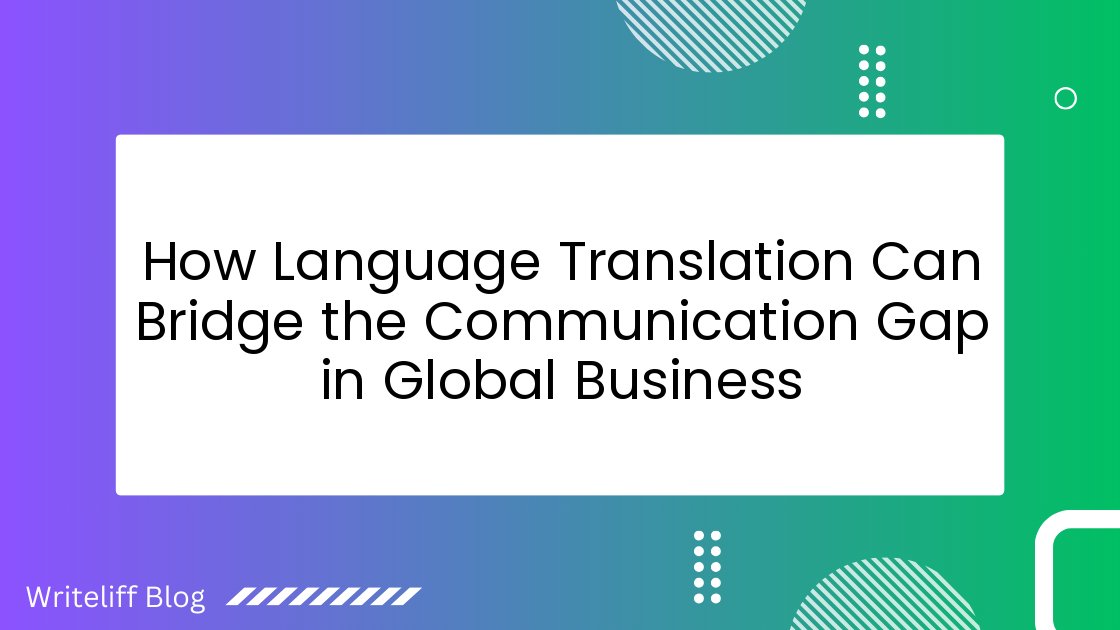How Language Translation Can Bridge the Communication Gap in Global Business

Greetings! As a proud owner of a translation business specializing in professional translation services, I am well aware of the crucial role language translation plays in bridging the communication gap in today’s globalized business world. In this blog post, I will explore the significance of language translation and how it enables seamless communication across borders. Join me as we delve into the fascinating world of language translation and its impact on global business.
The Power of Language Diversity
Language diversity is a fundamental aspect of our world, with over 7,000 languages spoken globally. Each language represents a unique culture, identity, and way of thinking. Embracing this diversity is crucial for businesses aiming to expand their reach and connect with a wider audience. Let’s explore how language translation facilitates effective communication in global business:
1. Breaking Down Language Barriers
In international business settings, language barriers can hinder communication and limit opportunities for collaboration. Language translation acts as a powerful tool to overcome these barriers and ensure effective understanding between parties. Here’s how it helps:
- Facilitating Multilingual Communication: Translation allows individuals speaking different languages to communicate seamlessly, fostering cooperation and enabling successful negotiations.
- Enhancing Business Relationships: By offering translations of marketing materials, contracts, and other business documents, companies can demonstrate their commitment to understanding and respecting the language and culture of their target markets.
- Enabling Global Market Expansion: Professional translations enable businesses to penetrate new markets, reach a broader customer base, and increase international sales. It allows companies to effectively convey their brand message and connect with potential customers in their native language.
2. Maintaining Cultural Authenticity
Language is intricately linked to culture. Translation not only transfers words from one language to another but also captures the essence, tone, and cultural nuances of the original message. This is particularly important in global business scenarios where cultural sensitivity and understanding are key. Consider the following:
- Transcreation: Sometimes, a direct translation may not effectively convey the intended message due to cultural differences. In such cases, professional translators use transcreation to adapt the content while maintaining its essence and impact. This ensures that the message resonates with the target audience on a cultural level.
- Localization: Localization goes beyond translation by adapting content to suit the cultural preferences and expectations of a specific locale. It involves modifying aspects such as images, colors, currencies, and even units of measurement to create a more personalized experience for the target market.
- Cultural Sensitivity: Professional translators possess in-depth knowledge of cultural norms and customs, allowing them to navigate potential pitfalls and prevent misunderstandings that may arise due to cultural differences. This helps businesses avoid costly and reputation-damaging mistakes.
The Role of Technology in Language Translation
In recent years, advancements in technology have revolutionized the field of language translation. Let’s explore how technology complements professional translation services:
1. Machine Translation and Human Expertise
Machine translation (MT) tools, such as Google Translate and DeepL, have made significant progress in their accuracy and speed. However, they still fall short when it comes to the complex linguistic and cultural aspects of business communication. This is where the expertise of professional translators shines:
- Post-Editing: Machine-translated content can be post-edited by human translators to ensure accuracy, clarity, and cultural relevance. This hybrid approach combines the efficiency of technology with the precision of human expertise.
- Quality Assurance: Professional translators follow stringent quality assurance processes to ensure the final translation meets the highest standards. This includes reviewing, proofreading, and editing the translated content to eliminate errors and maintain consistency.
2. Translation Management Systems (TMS)
Translation management systems have streamlined the translation workflow, making it more efficient and scalable. These systems facilitate collaboration between translators, project managers, and clients, ensuring smooth communication and timely deliveries. Key features of TMS include:
- Centralized Translation Assets: TMS allows businesses to build and maintain translation memories, glossaries, and style guides. These assets ensure consistency across translations and save time in future projects.
- Workflow Automation: TMS automates repetitive tasks such as file preparation, project assignment, and invoicing. This enables translators to focus on the linguistic aspects and enhances overall productivity.
- Real-Time Collaboration: TMS facilitates seamless collaboration between translators and clients, enabling instant communication, feedback, and file sharing. This promotes transparency and enhances project efficiency.
Embracing a Multilingual Future
The global business landscape continues to evolve, with increasing interconnectedness and cross-border collaboration. To thrive in this environment, businesses must embrace language translation as an integral part of their strategies. Here are some key takeaways:
- Invest in Professional Translation Services: Partner with reputable translation agencies or professional translators who possess the necessary linguistic skills, cultural understanding, and industry expertise to deliver accurate and culturally appropriate translations.
- Understand the Target Audience: Gain insights into the cultural and linguistic preferences of your target markets. Tailor your messaging accordingly to create a personalized and engaging experience for your customers.
- Stay Abreast of Language Trends: Languages evolve, and new trends emerge. Stay updated with language developments and evolving terminology to ensure your translations are relevant and resonate with your audience.
In Conclusion:
Language translation plays a vital role in bridging the communication gap in global business. It enables effective understanding, fosters cultural authenticity, and facilitates international collaboration. By leveraging professional translation services and embracing the power of language diversity, businesses can expand their horizons, connect with diverse audiences, and unlock new opportunities in the global marketplace.
Embrace the power of language translation and propel your business towards global success!